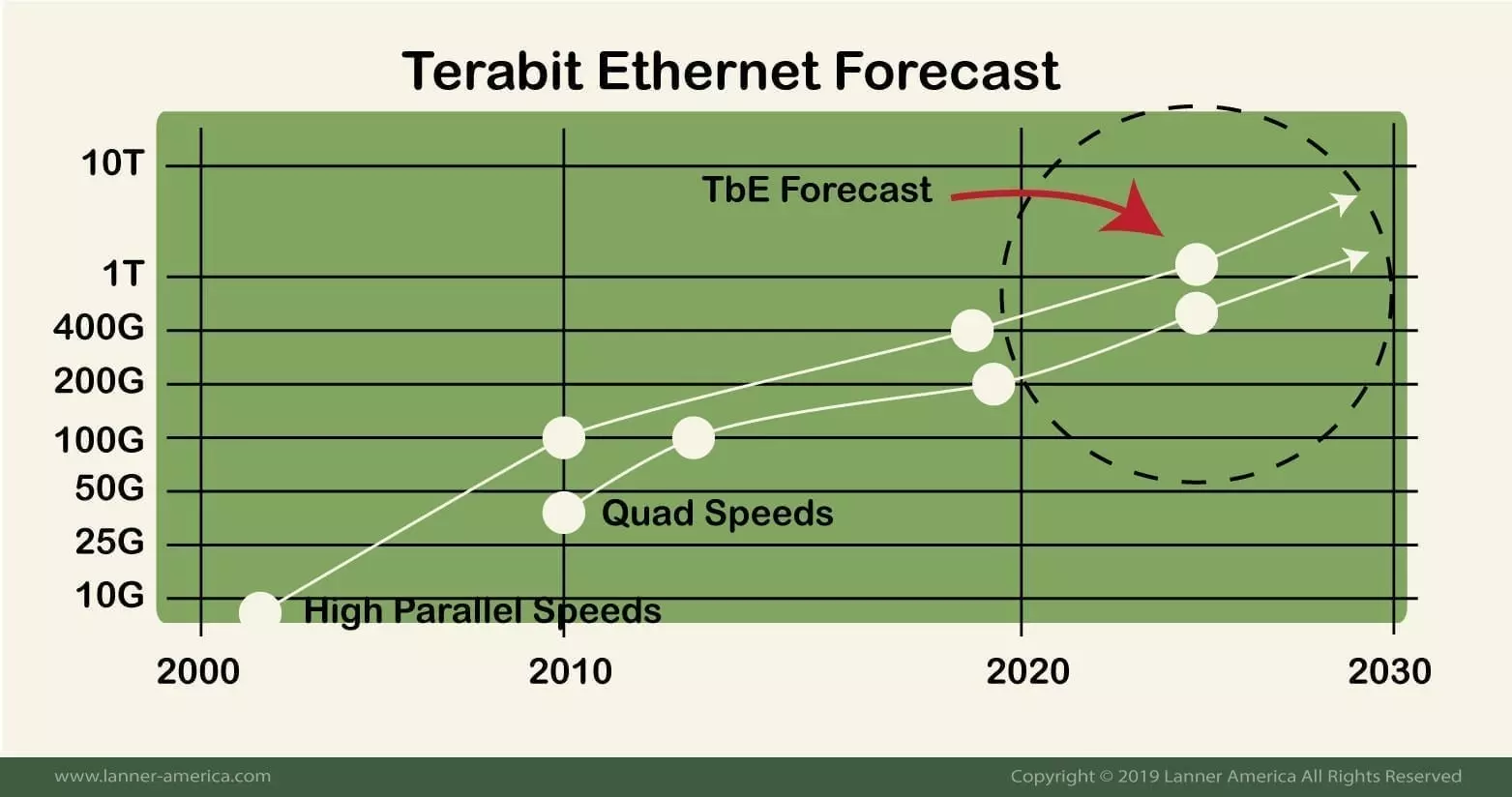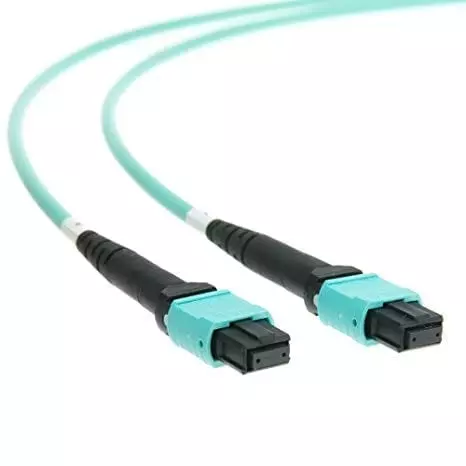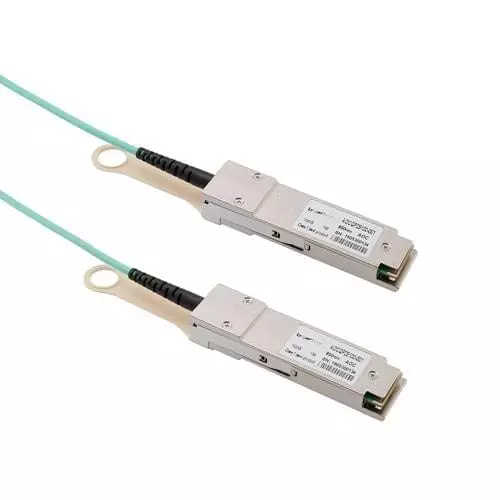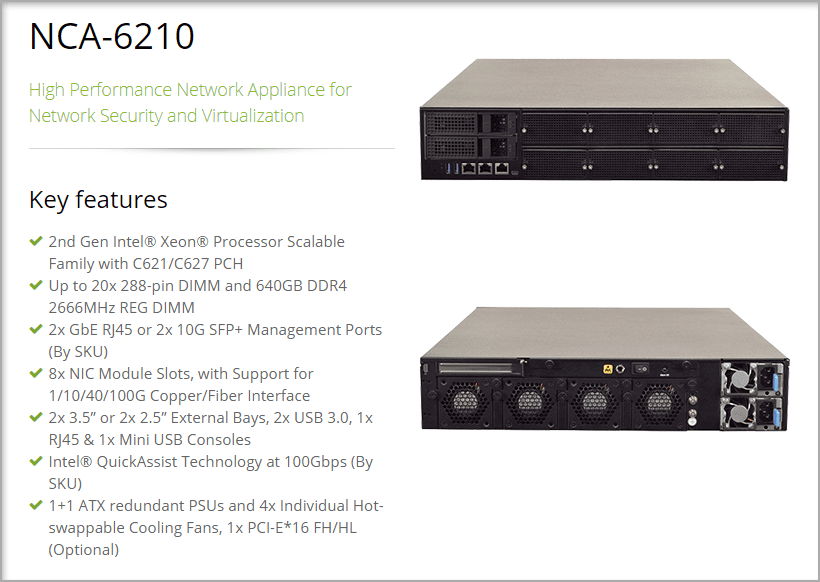
The longing one Terabit Ethernet is beginning to look like a reality.
Close to, but not yet, is the 400 Gbit/s Ethernet, which is already a reality. In fact, the 400 Gbit/s Ethernet has been proven at the 2019 European Conference on Optical Communication, by a large network provider.
While 100 Gigabit/s is rolling out everywhere, with switches aggregating multiple 100 Gigabit links with powerful small factor optical transceivers, 400 Gigabit/s is beginning to turn around the corner. Hyper-scale data centers from early adopters like Amazon, Google, and Facebook, are just starting to embrace the 400 Gigabit Ethernet (400GbE).
But, hold on to your seats, because we will probably not yet see the one terabit on a single link. At least in the coming years.
So, what is all the fuss about Terabit Ethernet speeds?
What is Terabit Ethernet?
If one Terabit (1 Tb) is the same as 1000 Gigabit, then one Terabit Ethernet (TbE) is precisely 1000 Gigabit Ethernet. But in the Ethernet world, the concept of Terabit Ethernet is just laying the foundation towards reaching real 1000 Gigabit/s Ethernet (1 TbE) speeds. Actual Terabit Ethernet speed is still not happening (as for 2019), but we will likely start seeing it in the near future.
So For now, people refer to Terabit Ethernet (TbE) to Ethernet speeds above 100 Gbps. Although 10GbE and 40GbE are more common, we are already starting to see 100GbE around, especially in large Data Centers and Enterprises.
The Evolution: From 1GbE to 1000GbE
The Gigabit Ethernet (GbE) came into being around 1999 and is now a standard in Ethernet cables for small-scale home networks. Then came higher speed standards, such as the 10GbE and 40GbE, which were defined by the same IEEE 802.3ba-2010 standard and are more common in data centers.
When the 100GbE standard came, the “race” to reach the Terabit Ethernet also came.
Back in 2012, the IEEE P802.3bs Task Force started to work on 200GbE and 400GbE standards, which are similar to the technology behind 100 Gigabit Ethernet. When 200GbE and 400GbE standards were approved in 2017, the networking vendors were already offering switches and transceivers that supported those technologies. These two technologies are expected to be seen around late 2020.
According to the Ethernet Alliance, the speeds above 800GbE, 1.0GbE, and even 1.6GbE are forecasted to become standards after a couple of years from now, possibly around 2025.

The Terabit Building Blocks
Reaching the level of Terabit Ethernet speeds is a matter of combining the right components. Cabling, ports, and networking devices.
Since the consensus of IEEE back in 2012, there has been a big effort from the networking industry to develop the right technology to support the Terabit Ethernet. This technology includes switching silicon, on-board optics, new optical/electrical interfaces, new modules such as the QSFP-DD, and more.
So, for now, what does it take to support Terabit Ethernet speeds?
- Cabling
- Optical Modules
- Switching
Cabling
Due to economics, copper cabling installations have been the preferred method for running Ethernet. Copper cables and their interfaces have always been considerably cheaper than fiber optics. In fact, today’s copper cables Cat6e and Cat7 can support 10GbE or even higher and are less expensive than fiber optics.
But now, fiber optics are becoming the new norm in data centers. Although copper is still cheaper, the advantages of running fiber optics over copper are substantially higher. And one of the biggest reasons for choosing fiber optic cables, especially for Terabit Ethernet, is its bandwidth.
For now, traditional data centers are using the 10Gb, and 40Gb Ethernet speeds over multimode fiber (MMF) or single-mode fiber (SMF) optics cabling. But fiber optics can go well over the 100Gbit/s speeds, something not possible with today’s copper standards.

Optical Modules
The optical modules are probably one of the most important components of the Terabit Ethernet technology, especially form-factors such as QSFP28, QSFP-DD, OSFP, and CFP8. These small form-factors are pluggable, low-power consumers, and interoperable with different vendors.
Nowadays, the QSFP28 small factor is beginning to be widely adopted. The networking equipment that supports the 100Gb will often come with the QSFP28.
The new QSFP-DD (Quad Small Form Factor Pluggable Double Density), in particular, is a new optical module that operates in 50 Gb/s PAM4 modulation over optical fiber. This module is capable of supporting 200 Gb/s and even 400 Gb/s of aggregate bandwidth.

Switching
Cables and interface modules are not the only key players that will help attain the Terabit Ethernet speeds. At the core of any Ethernet technology must be the interconnecting devices, such as switches or routers. To be able to support 100GbE or even 400GbE, the intelligence in the networking equipment also needs to be upgraded.
Some networking devices will need to have on-board level optics or right ASICs to handle the Terabit Ethernet speeds.
An excellent example of a high-performance network device that supports 100GbE connection speed is Lanner NCA-6210. This device uses the hardware technology, Intel Integrated QuickAssist technology, which accelerates critical workloads.
The device also comes with eight module slots that support up to 100G copper or fiber interfaces.

Ethernet vs Wireless
With the many advantages that wireless technologies provide, such as mobility, security, and speeds, many enterprise data centers still prefer wired networks as their main connection method.
Although wireless is awesome, Ethernet is not going away anytime soon. The high-capacity bandwidth, performance, and security that wired Ethernet offers have no match. And Terabit is proof.
Of course, wireless will be fundamental to lots of new technologies, such as IoT and mobility. On top of that, 5G and edge computing will help boost those technologies by taking a big load off of the core network and bringing the intelligence closer to the end-user. But the traffic will still need to be distributed at data centers. The Internet still needs the backbone to interconnect data centers together and connect its internal components.
Terabit Ethernet will be at the heart of these next-generation data centers and will also be foundational for advancements in cloud networking.
Other breakthroughs such as the new optical modules like QSFP28 and QSFP-DD, board-level photonics, fiber deployments, and modern networking equipment will give way to faster bandwidths. The new communications standards, such as Flexible Ethernet (FlexE), Media Access Control Security (MACsec) link encryption, will also help improve bandwidth and allow the Terabit Ethernet.
Final Words
For now, there is still no standard that enables the One Terabit/s over Ethernet over a single optical cable (or wavelength).
But the promise to reach the terabit Ethernet is closer than it seems. Aggregating a couple of 100GbE on a multiple-port switch can well reach over the 1 Terabit/s over Ethernet.







